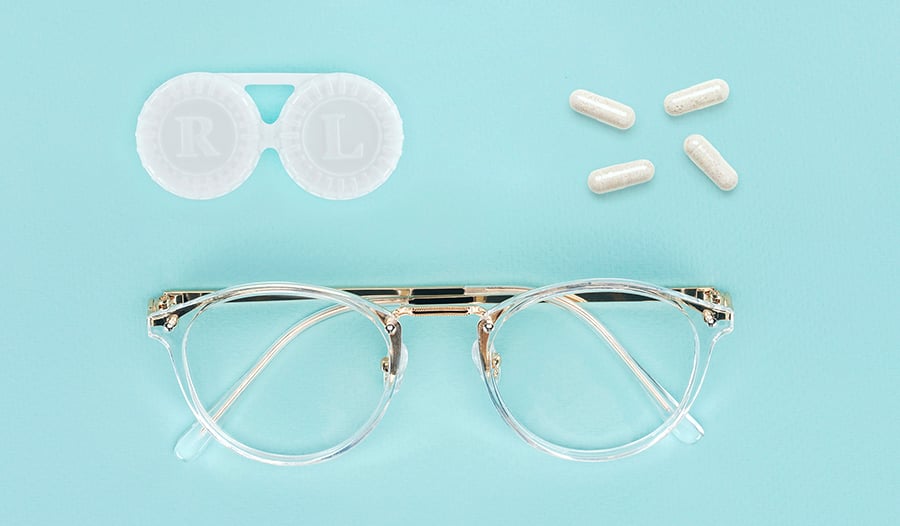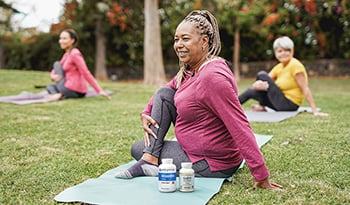How Lutein & Zeaxanthin Help Protect Vision & Eye Health
DISCLAIMER:This blog does not intend to provide diagnosis...
- In this article:
- Do You Have Digital Eyestrain?
- How Blue Light Affects Your Eyes
- Lutein & Zeaxanthin to the Rescue
- Supplements Could Provide Powerful Protection
- Who Should Take Lutein & Zeaxanthin Supplements?
- 5 More Ways to Protect Your Vision

There's no question that we are living in a digital age. According to a report from eMarketer, in 2020, Americans spent an average of nearly eight hours a day on digital media—and screen time is creeping up.1
While this engagement keeps us connected, informed, and entertained, much exposure to smartphones, tablets, computers, and other digital devices also has a downside. It can disrupt sleep, reduce physical activity, contribute to weight gain, and affect physical and mental health.2
Another adverse effect doesn't get the attention it deserves: Excessive digital screen time can also impact your vision and eye health.
Do You Have Digital Eyestrain?
A survey conducted by The Vision Council found that more than 60% of Americans reported eye issues after spending extended time on digital devices. Symptoms of digital eyestrain included:3
- Blurred vision
- Dry eyes
- Itchy, red, or burning eyes
- Achy head
If left unchecked, digital eyestrain worsens your quality of life and could potentially have extended effects on your eyes.4
The Culprit? Blue Light
A primary culprit in digital eyestrain is blue light. Blue light is a high-energy wavelength of light in sunlight and artificial lights, including fluorescent tubes and light-emitting diodes (LEDs).
LEDs are everywhere. They have primarily replaced incandescent bulbs, which are slated to be phased out next year, and are used to backlight digital displays in smartphones, tablets, computer screens, and TVs.
There is nothing inherently wrong with blue light. It's a natural part of the full spectrum of sunlight, and exposure during the day, especially in the morning, increases alertness, boosts mood, and helps to regulate circadian rhythms.5
The issue is that blue light is much more concentrated in digital devices. Plus, you are exposed to that light closeup for hours at all times of the day, evening, and, for some, even at night. This can adversely affect your sleep and other aspects of your health, including your vision and eye health.
How Blue Light Affects Your Eyes
Everybody knows ultraviolet (UV) light can cause sunburn, skin aging, and skin cancer. That's because UV is a short wavelength of light, and short wavelengths produce lots of energy.
Blue light is also a short, high-energy wavelength. As with UV light, prolonged exposure triggers the production of free radicals that can cause oxidative stress, inflammation, and DNA damage.6
Hours staring at a screen bombard your eyes with blue light, which penetrates to your retina, a thin layer of tissue at the back of the eye that communicates with your brain. The macula, a small area of the retina that manages your central vision and allows you to see fine details, is particularly vulnerable.
Excessive exposure to blue light can lead to blurred vision, trouble focusing, eye dryness, irritation, and other symptoms of digital eyestrain. Although improvements are usually noted when you give your eyes a break, oxidative damage to the retina and macula accumulates over time. It can contribute to vision problems, especially as we age.
Lutein & Zeaxanthin to the Rescue
Your eyes have a built-in shield that protects against free radical damage from blue light. The macular pigment, because of its yellow color, is composed of three carotenoids: lutein, zeaxanthin, and meso-zeaxanthin. These carotenoids are potent antioxidants that absorb blue light and neutralize free radicals before they do harm.
A high macular pigment optical density (MPOD), indicative of robust concentrations of lutein and zeaxanthin (including meso-zeaxanthin), is one of the best indicators of macular health. If your MPOD is low, blue light slips past, putting your macula and overall eye health at risk.7
Boosting your levels of lutein and zeaxanthin—the only carotenoids that block blue light and counter free radical damage—can help.8 Your body can't produce these carotenoids, so you have two options: diet and supplements.
The richest dietary sources of lutein and zeaxanthin are kale, collards, mustard greens, Swiss chard, and spinach. Egg yolks, broccoli, peas, and other vegetables contain some, although in much lower amounts.
Unfortunately, studies reveal that the average American gets just 1–2 mg of these carotenoids in their daily diet.9 Yet, for optimal protection you need a minimum of 20 mg lutein/zeaxanthin per day.
So that leaves supplements.
Supplements Could Provide Powerful Protection
Scores of scientific studies back the benefits of supplemental lutein and zeaxanthin, and it is a growing field of research. Here are some of the highlights:
- Reduces symptoms of digital eyestrain: Young adults who spent about eight hours a day on digital screens were enrolled in a six-month double-blind, placebo-controlled clinical trial to test the effects of a particular lutein/zeaxanthin extract (Lutemax 2020®). Compared to the placebo group, those who took Lutemax significantly improved eyestrain, eye fatigue, glare, and achy head. They also reported better sleep.10
- Decreases effects of glare: This same lutein/zeaxanthin extract was shown in another six-month trial to improve glare tolerance and speed vision recovery after bright light exposure.11
Improves night vision: A placebo-controlled study involved drivers aged 25-47, who spent more than 10 hours a day behind the wheel. After taking 20 mg of lutein daily for one year, drivers reported significant improvements, especially in glare sensitivity and driving at night.12
- Increases MPOD: Numerous studies have shown that supplemental lutein and zeaxanthin increase MPOD—and the higher the dosage, the more significant the difference in the protective macular pigment.13
Additional benefits of supplemental lutein and zeaxanthin that have been demonstrated in clinical trials include improvements in attention, cognitive function, stress, and sleep.
Who Should Take Lutein & Zeaxanthin Supplements?
Supplementation is crucial if you aren't getting enough of these essential carotenoids in your diet—and most people aren't. Other considerations include:
- Anyone who spends a lot of time looking at digital screens, especially those with any symptoms of digital eyestrain.
- For people over age 50, levels of lutein and zeaxanthin tend to drop as we age.
- Individuals who have issues driving at night, adjusting to dark surroundings, or recovering from bright light and glare.
The suggested daily dose is 20–40 mg of lutein and 2–4 mg zeaxanthin. Make sure your supplement also includes meso-zeaxanthin, as both forms are important.
Although most of the studies lasted at least six months, many people noticed improvements in eyestrain, glare reduction, and other symptoms sooner.
Even if you don't notice dramatic changes, rest assured that by nurturing your macular pigment and increasing your MPOD, you are safeguarding your eyes today and for years to come.
5 More Ways to Protect Your Vision
In addition to optimizing your lutein and zeaxanthin levels, here are five more ways to protect your eyes against digital eyestrain.
- Reduce screen time. This is especially important for children, adolescents, and young adults. A 2021 meta-analysis published in a Lancet journal linked excessive use of smartphones and tablets with a 30% higher risk of myopia (nearsightedness). Risk increased by 80% when combined with prolonged computer use.14
- Take frequent breaks. Adopt the 20-20-20 rule—every 20 minutes, shift your eyes and look at something about 20 feet away for a minimum of 20 seconds.
- Use lubricating eye drops. Studies reveal that we blink less when looking at digital displays, which can lead to dry eyes. Using over-the-counter lubricating eye drops (artificial tears) can help.
- Adjust your computer screen. Place your screen about an arm's length away in a position that reduces glare, and correct the brightness, contrast, and type size, if needed.
- Wear blue-light-blocking glasses or contacts. If you need glasses or contacts while using your computer or other devices, check out special coatings that block blue wavelengths of light. Although supportive research isn't definitive, a study that tested various types of lenses found that by filtering out blue light, they reduced potential damage by 10%–24%. They also decreased light-induced melatonin suppression.15
References:
- Cramer-Flood E. US Time Spent with Media 2021 Update. eMarketer. 2021 Feb https://www.emarketer.com/content/us-time-spent-with-media-2021-update#page-report
- Apurvakumar P, et al. Social Connectedness, Excessive Screen Time During COVID-19 and Mental Health: A Review of Current Evidence. Front. Hum. Dyn, 2021 July 22.doi.org/10.3389/fhumd.2021.684137
- The Vision Council. The Vision Council Shines Light on Protecting Sight—and Health—in a Multi-Screen Era. 2018 Jan. https://thevisioncouncil.org/blog/vision-council-shines-light-protecting-sight-and-health-multi-screen-era
- Auffret É, et al. Digital eye strain. Symptoms, prevalence, pathophysiology, and management. J Fr Ophtalmol. 2021;44(10):1605-1610. doi: 10.1016/j.jfo.2020.10.002
- Wahl S, et al. The inner clock-blue light sets the human rhythm. J Biophotonics. 2019;12(12):e201900102. doi:10.1002/jbio.201900102
- Ouyang X, et al. Mechanisms of blue light-induced eye hazard and protective measures: a review. Biomed Pharmacother. 2020;130:110577. https://www.sciencedirect.com/science/article/pii/S0753332220307708
- Arunkumar R, et al. What do we know about the macular pigment in AMD: the past, the present, and the future. Eye (Lond). 2018;32(5):992-1004. doi:10.1038/s41433-018-0044-0
- Ma L, et al. Lutein, Zeaxanthin and Meso-zeaxanthin Supplementation Associated with Macular Pigment Optical Density. Nutrients. 2016;8(7):426. Published 2016 Jul 12. doi:10.3390/nu8070426
- Ranard KM, et al. Dietary guidance for lutein: consideration for intake recommendations is scientifically supported." European journal of nutrition vol. 56,Suppl 3 (2017): 37-42. doi:10.1007/s00394-017-1580-2
- Stringham JM, et al. Macular Carotenoid Supplementation Improves Visual Performance, Sleep Quality, and Adverse Physical Symptoms in Those with High Screen Time Exposure. Foods. 2017;6(7):47. doi:10.3390/foods6070047
- Stringham JM, et al. Macular carotenoid supplementation improves disability glare performance and dynamics of photostress recovery. Eye and Vis. 2016;3(30). https://doi.org/10.1186/s40662-016-0060-8
- Yao Y, et al. Lutein supplementation improves visual performance in Chinese drivers: 1-year randomized, double-blind, placebo-controlled study. Nutrition. 2013;29(7-8):958-964. doi:10.1016/j.nut.2012.10.017
- Ma L, et al. 2016.
- Foreman J, et al. Association between digital smart device use and myopia: a systematic review and meta-analysis. Lancet Digit Health. 2021;3(12):e806-e818. doi:10.1016/S2589-7500(21)00135-7
- Leung TW, et al. Blue-Light Filtering Spectacle Lenses: Optical and Clinical Performances. PLoS One. 2017 Jan 3;2017;12(1):e0169114. doi: 10.1371/journal.pone.0169114

 By Dr. Julian Whitaker M.D.
By Dr. Julian Whitaker M.D.


